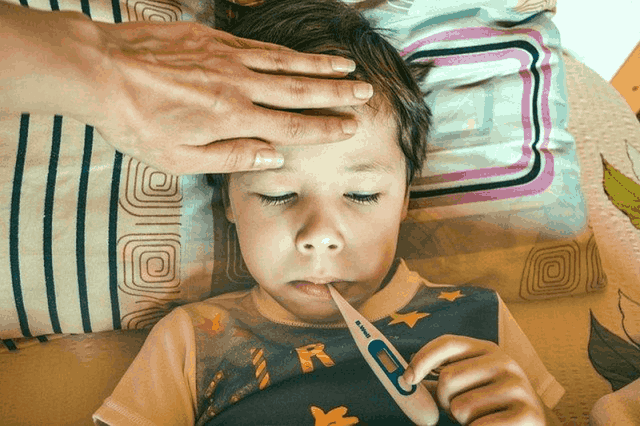What is Pyrexia of unknown origin? What are the signs and symptoms of Pyrexia? How to diagnose and treat this medical codition?
Table of Contents
What Does Pyrexia Mean?
Fever is clinically termed Pyrexia, where fever is a condition of an abnormal rise in body temperature. Pyrexia or fever is a vital characteristic of many diseases that affect our bodies. Though Pyrexia is observed in conditions; like an infection through microorganisms. They may also show up in the cases of severe pathological conditions like cancer and specific blood disorders. It may also be due to a few body reactions to stress, exhaustion, or sudden strenuous exercise.
How does Pyrexia work in the human body?
Pyrexia, as mentioned earlier; is called fever and the majority of us are aware that; the increase in body temperature causes fever. An average body temperature is 99.6 Fahrenheit. Therefore, any fluctuation in temperature is called fever.
Pyrexia is a typical immune response of the body’s immunity system that safeguards the body against any new organism that enters the body system. Temperature is also recorded through a medical instrument called a thermometer. Moreover, the temperature is taken; orally or through the axillary regions. You can reach out to a viral pyrexia treatment in case you have a viral fever.
The organ responsible for the increase in temperature
Hypothalamus is a tiny gland located in the brain, and it is responsible for maintaining the temperature. The body releases pyrogens in response to any injury or microorganisms in the body. Once the hypothalamus senses the presence of pyrogens in the body, it transmits the signal to the body, which increases the temperature. Thus, the body’s temperature rises to make the conditions unfavorable for the microorganisms to multiply.
Also Read: Ten Inexpensive Solutions For Sinus Problems
What Causes Pyrexia?

Two condition cause Pyrexia:
Both infectious and non-infectious conditions cause Pyrexia. Doctors cannot identify the cause of it unless you undergo diagnostic tests.
Infectious conditions
- Bronchitis- It is a kind of respiratory infection
- Tuberculosis – It is a bacterial infection
- Urinary tract infection
- Osteomyelitis – This is a bone infection that can show pyrexia symptom
- Endocarditis – It is a cardiac tissue infection caused by bacteria.
Non-infectious conditions
- Brain fever or hemorrhages
- Leukemia and renal cell carcinoma
- Reactive drugs
- Blood transfusion reaction
Also Check: Self-Diagnosis Online Dangers And How To Avoid Them
What Are The Types of Pyrexia of unknown Origin?
There are four three of Pyrexia of unknown origin:
- Classic
- Nosocomial
- Immune Deficient
Classic Pyrexia of Unknown Origin
Classic FUO influences beforehand sound individuals. It’s characterized as an unexplained fever that goes on for a long time. So, contamination or neoplasms, like leukemia, may cause exemplary FUO. Different issues, for example, infections that influence connective tissue, can likewise be the reason.
Nosocomial Pyrexia of Unknown Origin
People who have nosocomial Pyrexia of unknown origin may need to be hospitalized at the onset of fever. The cause of nosocomial type includes:
- Enterocolitis
- Sinusitis
- Deep vein thrombosis
- Septic thrombophlebitis
Immune Deficient Pyrexia of Unknown Origin
Immune deficient Pyrexia happens in individuals with compromised insusceptible frameworks. This puts them at increased danger of contamination. A compromised resistant framework can regularly occur as a result of chemotherapy treatment.
Also Read: Why People Love Kybella Double Chin Treatment Procedure All Over The World?
Pyrexia Signs And Symptoms

Signs and symptoms of Pyrexia include:
- Shivering
- Headache
- Body ache
- Weakness
- Irritability
- Dehydration
- Loss of appetite
- Joint pains
- Sweating
Diagnosis of Pyrexia
People affected with malaria can reach out to a malaria hospital. Before recommending tests, your doctor may ask you a few questions about your health, any changes you may have undergone in food, or climatic or environmental changes you have experienced. Then, you may give your blood sample for further analysis.
Your PCP may likewise run blood tests to check for specific conditions, including immune system conditions that probably won’t have numerous conspicuous manifestations. They’ll inspect your skin cautiously for indications of whiteness, rash, or jaundice.
If blood work or the actual test turns up any specific pointers, the specialist will arrange more tests before confirming a finding.
Culture Examination
Blood, urine, and sputum cultures might be utilized to check for purposes like microorganisms and growths. Special tests can likewise help check for abnormal bacterial, parasitic, or viral diseases.
Imaging Tests
An Endocardiogram might be used to assess your heart; if your primary care physician hears a mumble or emphatically presumes endocarditis. This is a contamination of one of the heart valves. In addition, chest X-rays might be used to assess the lungs.
Also Check: Best Tips On How To Get Rid Of Dandruff?
How to Treat Pyrexia?

Pyrexia of Unknown Origin Treatment
Treatment for Pyrexia of unknown origin differs depending upon the reason. Various hospitals provide dengue treatment in Coimbatore.
Nonsteroidal calming drugs (NSAIDs) and antihistamines, doctor may also use to treat FUOs with no hint of fundamental causes. In many individuals, these drugs can also assist with decreasing the actual fever. The dosage must be precise as recommended by the doctor, because, only the correct dosage can help in pyrexia recovery.
Individuals whose fevers are thought to have a lacking resistant beginning might be treated with an expansive range of antimicrobials. Contaminations are also answerable for somewhere between 20 and 40 percent of all fevers of obscure origin. It is necessary to get proper rest and consume plenty of fluids.
From that point forward, any related manifestations or confusions that might originate from it will also be tended to. Reach out to a hospital where you can find viral fever treatment.
At-home treatment
Pyrexia at times is a chronic health condition, and at times when there is an underlying health condition, Pyrexia might be the symptom of a severe health condition. There is a set of few things that you can follow for a home treatment for Pyrexia. When affected with it, children and infants need to check for stiff neck, prolonged crying, trouble breathing, and appearance of rashes on the body. In such cases, you need to visit a specialist for proper treatment.
Also Check: Metabolic Bone Disease – Symptoms, Causes, Diagnosis, Treatment And Prevention In Human
Risk factors for Pyrexia
Pyrexia can be related to various risk factors:
- Sinusitis
- Allergic rhinitis (hay fever)
- Bronchitis
- Rheumatoid arthritis
Complications of Pyrexia
Not all fevers can lead to complications. Also, fevers above 104 Fahrenheit can show complications like:
- Seizures
- Coma
- Brain damage
- Death
Since delayed occasions, individuals with high-grade fever and those with fever require prompt clinical treatment to forestall the advancement of complications because of a weakened immune framework. Kids under the age of below five years might get febrile seizures; (which is set apart by the deficiency of cognizance, hardening, jolting, and swooning); when the temperature arrives at greater than 103ᵒF.
Identifying Pyrexia in infants

Specific side effects require prompt clinical consideration. This incorporates in case your kid’s fever goes up to 103°F. You ought to likewise contact the pediatrician if your kid:
- Cries miserably
- Has a solid neck
- Battles to relax
- Have purple rashes shown up on the skin
- Experiences difficulty awakening
- Difficulty in swallowing
Also Check: 4 Ways How To Lower High Heart Rate
Tips to control Pyrexia
Fever itself isn’t a sickness however is an indication that alarms you about some fundamental contamination or ailment. The accompanying medical aid measures are practical while treating fever:
- Drink a lot of liquids.
- Use covers to control shivering.
- Rub the palms and soles (the peripheral portions of the body) to expand the body’s inside temperature.
- Use over-the-counter prescriptions like Paracetamol to diminish the internal heat levels, but just to a restricted portion, and look for specialist guidance before utilizing them for a drawn-out time frame.
Preventive measures to follow that can help you avoid
- Maintaining your body hygiene.
- Washing hands constantly before eating
- Utilizing hand sanitizers where there is no admittance to water
- Covering the nose and mouth when traveling can help forestall the section of infection-causing life forms into the body.
- You should avoid sharing plates, glasses, or cups alongside others.
Following a healthy hygiene regime and avoiding consuming foods that can cause reactions in your body can help you stay away from Pyrexia. Always look out for symptoms when you have Pyrexia. That way, any minor complication can be prevented and also treated immediately with the help of medical support.
Must Check: Sign And Symptoms Of Lung Disease That Causes Shortness Of Breath


Comments are closed.